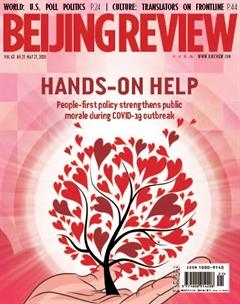Two Sessions At a Critical Moment
By Lan Xinzhen

The 2020 annual sessions of the National Peoples Congress, the top legislature, and the National Committee of the Chinese Peoples Political Consultative Conference, the top political advisory body, will kick off on May 22 and 21, respectively. Rescheduled from March over coronavirus concerns, the Two Sessions, which are among the most important annual political events in China, are set to be special.
This year has long been earmarked as the deadline for completing building a moderately prosperous society in all respects and marks the end of the 13th Five-Year Plan (2016-20).
The unexpected outbreak of the novel coronavirus disease (COVID-19) disrupted Chinas social and economic development in ways unseen in decades. The GDP contracted by 6.8 percent year on year in the fi rst quarter, the fi rst decline since at least 1992 when official quarterly growth data started to be published.
Chinas economic growth prospect and its fiscal and monetary policies for 2020 have attracted a lot of attention. Although China has clinched an initial victory in the battle against the disease, with factories resuming production and the economy rebooting, there are many uncertainties and tremendous efforts are needed to accomplish its development goals this year.
The Political Bureau of the Central Committee of the Communist Party of China held a meeting on April 17 to discuss epidemic prevention and control measures and economic development. According to the meeting, the current challenges to economic development are unprecedented, and thus there must be a full assessment of the difficulties, risks and uncertainties ahead. All work on social and economic development must be carried out with a sense of urgency.
Faced with great downward pressure, will China be able to hit the target of poverty alleviation and become a moderately prosperous society in all respects on schedule? The Two Sessions will provide clues.
While the economic picture at home may seem challenging, the international environment is complex and severe. Cross-border trade and travel have plunged amid the coronavirus pandemic, hammering Chinas foreign trade.
Moreover, the U.S. has launched massive fi scal and monetary stimulus measures to alleviate the damage and sustain economy during the pandemic, which will have a significant spillover effect on the Chinese and the global economy.
Due to ineffective and delayed response by Donald Trumps administration, the U.S. now tops the global list of confirmed cases of and deaths from COVID-19. In an attempt to defl ect responsibilities and find scapegoats, some U.S. politicians are threatening to hold China accountable for the coronavirus outbreak in an attempt to cancel the debts the U.S. owes to China, and re-impose high tariffs on Chinese imports. Some are even making use of the Taiwan question and affairs in Hong Kong Special Administrative Region to obstruct Chinas development.
These complicated internal and external landscapes pose a major test for China. How to face up to challenges and uncertainties both at home and abroad will be the focus of the Two Sessions.
Reform will also be a key part of the agenda of the Two Sessions once again. Reform has long been regarded as key to fostering new drivers for economic growth. Industrial transformation and upgrading is at a critical stage, and only by advancing reforms can we see these new forces prevail. In addition, new reforms concerning the income distribution system, state-owned enterprises and the fi nancial sector can also be expected, together with innovative reforms that have been launched during the combat against COVID-19.
The Two Sessions will provide some certainty as to how the world will continue in a post-pandemic future. At the least, the world can glean information about Chinas plan for its own social and economic growth. Also, the Two Sessions will show the world Chinas commitment to peace, cooperation and development under the vision of building a community with a shared future for humanity.

